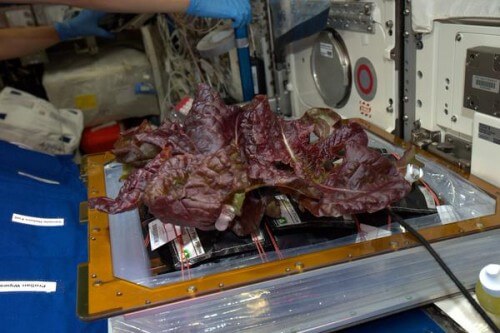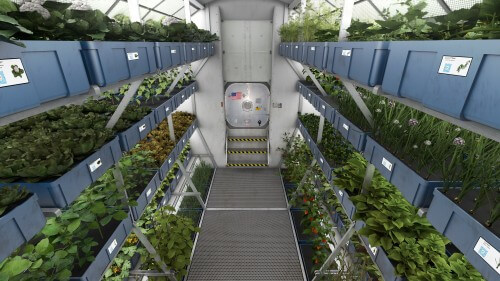A few days ago the astronauts on the space station harvested the red lettuce crop from the Veggie plant growing system and today they ate the leaves to their heart's content. The purpose of the experiment is to try "vertical farming" growing methods in space conditions for the purpose of improving the nutrition and mood of the astronauts, and in preparation for long missions

NASA plans to grow in the future spaceships and colonies on other planets, plants that will be used as food supplements for the astronauts who until now mainly live on canned food.
This is of course with one exception - the Russian space station Mir, but then the meal was due to a delay in receiving supplies due to events that occurred on the ground during the breakup of the Soviet Union. One of the old traditions created in Mir, and also transferred to the space station, is filling the remaining volume in the Progress model supply spacecraft, just before launch, with fresh vegetables and fruits.
Fresh food grown in a microgravity environment in space has officially entered the menu of NASA astronauts on the space station for the first time. Members of the 44th crew, including Scott Kelly of NASA who is on the station for a year's stay, tasted the fruits of their labor yesterday after harvesting a crop of red lettuce from the station's Veggie Plant Growing System.

The astronauts cleaned the vegetable leaves with citric acid-based disinfectant wipes before eating half of them. The rest of the crop remains packed and frozen on the station until it is returned to Earth for scientific analysis.
The NASA experiment known as Veg-01 was carried out with the aim of studying the function and capabilities of a plant growing device and rooting pads containing its seeds in space conditions.
NASA seeks to develop veggie technology aboard the space station to provide future pioneers with sustainable food supplements as a critical component of the journey to Mars. During the long journeys in the solar system, Veggie will be used to grow food for the crew members, as well as another facility for leisure activities for astronauts who enjoy gardening.
The first seed pods were placed in the facilities, watered and tended by Crew 39 astronaut Steve Swanson in May 2014. After 33 days of growth, the plants were harvested and returned to Earth for food safety analysis. The second set of pads was sown by Scott Kelly on July 8 and the lettuce that grew on them was harvested after 33 days. The seeds stayed at the station for 15 months before they germinated.
The Veggie system was developed by Orbital Technologies (ORBITEC) in Madison, Wisconsin, and was tested at the Kennedy Space Center before flight. Veggie, with two pillow sets containing lettuce seeds and one set of zinnia flowers was sent to the space station on SpaceX's third cargo mission in April 2014.
The purple/pink hue surrounding the Veggie plants is the result of a combination of the red and blue lights, which emit more light than the green LEDs. Green LEDs were added to make the plants look like edible food rather than weird purple plants.
"The blue color and the red wavelengths are the minimum needed to grow plants well." Says Dr. Ray Wheeler, Director of the Office of Advanced Life Support Activities in the Research and Planning Unit at the Kennedy Office of Technology. "These wavelengths are extremely efficient in terms of electrical energy conversion. The green LEDs help to improve the human visual perception of the plants, but they did not add as much light as the red and blue bulbs."
Wheeler and his staff previously conducted similar experiments in growing plants in hydroponic units at NASA's Desert Experiment Site in Arizona. According to him, Veggie will help NASA learn more about growing plants in controlled environments, including vertical farming - growing plants in hydroponic facilities and then irradiating them with red and blue light sources. This type of system is popular in certain Asian countries and is starting to become common in the US as well.
"There is evidence that fresh foods, such as tomatoes, blueberries and red lettuce are a good source of antioxidants. The availability of fresh food in space may have a positive effect on the mood of the astronauts and may also provide some protection from radiation in space," Wheeler said.
Besides the nutritional benefits, fresh produce in space may also provide a psychological advantage. says Alexandra Whitemire, a scientist at NASA's Johnson Space Center in Houston. Her team focuses on the study of behavior, performance, communication and psychosocial adjustment of team members.
More of the topic in Hayadan:
